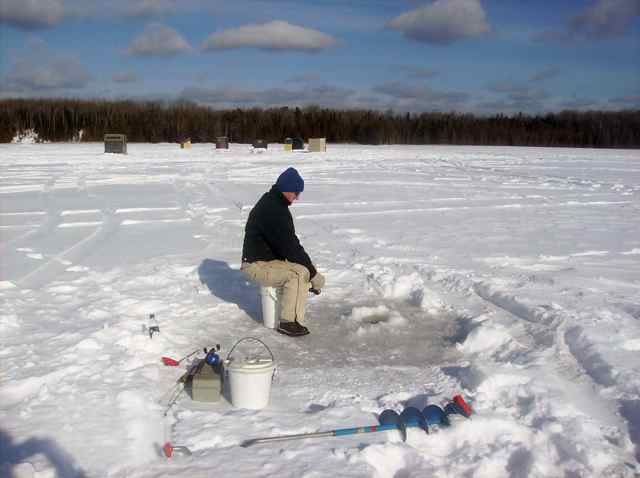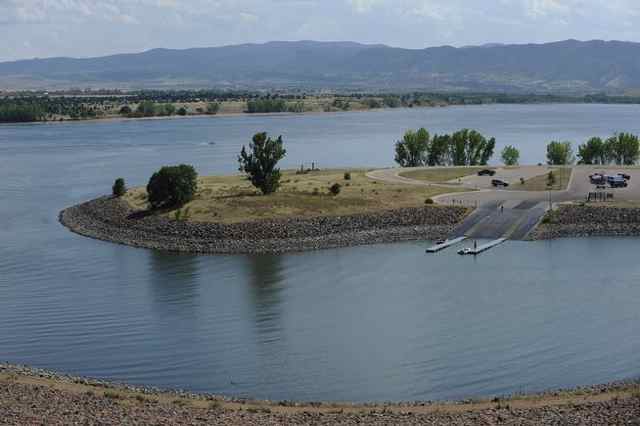ICE SAFETY TIPS FROM COLORADO PARKS & WILDLIFE

by Colorado Parks & Wildlife
12-13-2013
Website
COLORADO SPRINGS, Colo. - Colorado's early winter blast has brought freezing temperatures and ice to the state. But despite the chill, Colorado Parks and Wildlife is reminding people that lakes, ponds and streams still may not be ready for winter activity. Here are a few basic safety rules to follow when enjoying winter adventures on the ice.
Always assume that unsafe ice conditions may exist and remember ice thickness will vary from place to place and day to day. Four inches of ice is generally considered safe for ice fishing and ice skating. However, OHVs need at least five inches of ice thickness. Whenever there is any question about thickness or conditions the best advice is to stay off the ice.
Look for signs of unsafe conditions, including ice of different colors, water on top of the ice, cracks, pressure ridges, open water and bubbles in the ice. Also, beware of ice covered with snow. Sometimes the snow serves as insulation, keeping the ice from melting. Other times, the snow has the opposite effect, insulating the surface from freezing. Also be aware that water levels can fluctuate in reservoirs which can affect ice stability.
If you do choose to venture onto the ice, remember the following ice safety tips:
Never go onto the ice alone. Having someone with you means your partner can call or send for help if you fall in.
Remember Reach-Throw-Go. If you are with someone who falls through the ice use this approach. If you can't reach the person from shore, throw them a floatation device or rope. If you still can't help the person quickly - go for help. Never attempt to walk out onto the ice to rescue your friend because you might also fall through the ice.
Avoid alcoholic beverages. Alcohol increases your chance for hypothermia, which is the loss of body temperature. It can also lower your inhibitions, increasing the likelihood that you might take risks you otherwise wouldn't take.
Always wear a life jacket. Wear a lifejacket or personal flotation device (PFD) over winter clothing. Life jackets can provide excellent flotation and protection from hypothermia.
Assemble a personal safety kit. Always wear a safety kit on your body when going out onto the ice. Safety kits should include an ice pick, rope and a whistle to call for help.
Always keep your pets on a leash. Never allow your dog to run out onto the ice and never walk your dog near a frozen lake or pond without a leash. If your dog falls through the ice, do not attempt a rescue. Go for help. If the ice couldn't support the weight of your animal, it can't support you.
Even with the best planning and preparation, accidents can happen. If you do fall through the ice, remember the following:
Don't panic. Try to remain calm to conserve as much energy as possible. Try to get your arms onto the ice and kick as hard as you can with your feet to help lift you onto the ice, and then roll to safety. If you can't get out of the cold water by yourself, take the following appropriate actions to extend your survival time while waiting to be rescued.
Do not swim. Swimming will cause your body to lose heat much faster than if you stay as still as possible.
Act slowly and deliberately to conserve heat. Expect a progressive decrease in your strength and ability to move. Make the harder maneuvers at the beginning, while you can.
Keep your upper body above water. Keep your head and upper body as far out of the water as reasonably possible to conserve heat.
There's lots of outdoor fun to enjoy in Colorado but please do so carefully. No one can guarantee you that the ice is safe. The decision to go onto the ice is personal and should be made only after taking all the precautions to reduce the risk.
Always assume that unsafe ice conditions may exist and remember ice thickness will vary from place to place and day to day. Four inches of ice is generally considered safe for ice fishing and ice skating. However, OHVs need at least five inches of ice thickness. Whenever there is any question about thickness or conditions the best advice is to stay off the ice.
Look for signs of unsafe conditions, including ice of different colors, water on top of the ice, cracks, pressure ridges, open water and bubbles in the ice. Also, beware of ice covered with snow. Sometimes the snow serves as insulation, keeping the ice from melting. Other times, the snow has the opposite effect, insulating the surface from freezing. Also be aware that water levels can fluctuate in reservoirs which can affect ice stability.
If you do choose to venture onto the ice, remember the following ice safety tips:
Never go onto the ice alone. Having someone with you means your partner can call or send for help if you fall in.
Remember Reach-Throw-Go. If you are with someone who falls through the ice use this approach. If you can't reach the person from shore, throw them a floatation device or rope. If you still can't help the person quickly - go for help. Never attempt to walk out onto the ice to rescue your friend because you might also fall through the ice.
Avoid alcoholic beverages. Alcohol increases your chance for hypothermia, which is the loss of body temperature. It can also lower your inhibitions, increasing the likelihood that you might take risks you otherwise wouldn't take.
Always wear a life jacket. Wear a lifejacket or personal flotation device (PFD) over winter clothing. Life jackets can provide excellent flotation and protection from hypothermia.
Assemble a personal safety kit. Always wear a safety kit on your body when going out onto the ice. Safety kits should include an ice pick, rope and a whistle to call for help.
Always keep your pets on a leash. Never allow your dog to run out onto the ice and never walk your dog near a frozen lake or pond without a leash. If your dog falls through the ice, do not attempt a rescue. Go for help. If the ice couldn't support the weight of your animal, it can't support you.
Even with the best planning and preparation, accidents can happen. If you do fall through the ice, remember the following:
Don't panic. Try to remain calm to conserve as much energy as possible. Try to get your arms onto the ice and kick as hard as you can with your feet to help lift you onto the ice, and then roll to safety. If you can't get out of the cold water by yourself, take the following appropriate actions to extend your survival time while waiting to be rescued.
Do not swim. Swimming will cause your body to lose heat much faster than if you stay as still as possible.
Act slowly and deliberately to conserve heat. Expect a progressive decrease in your strength and ability to move. Make the harder maneuvers at the beginning, while you can.
Keep your upper body above water. Keep your head and upper body as far out of the water as reasonably possible to conserve heat.
There's lots of outdoor fun to enjoy in Colorado but please do so carefully. No one can guarantee you that the ice is safe. The decision to go onto the ice is personal and should be made only after taking all the precautions to reduce the risk.
< Previous Report Next Report >
< Previous Report
Next Report >

12-9-2013
DENVER - The Colorado Parks and Wildlife Commission will review the Chatfield Reservoir Reallocation Project Mitigation Plan when the Commission...... Read More

12-9-2013
DENVER - Although the main big game hunting seasons have ended, Colorado Parks and Wildlife's researchers and biologists are preparing...... Read More
More Reports
COLORADO PARKS AND WILDLIFE COMMISSION TO MEET IN PUEBLO 12/12 - 12/13
Chatfield Reservoir
12-9-2013
DENVER - The Colorado Parks and Wildlife Commission will review the Chatfield Reservoir Reallocation Project Mitigation Plan when the Commission...... Read More

12-9-2013
DENVER - Although the main big game hunting seasons have ended, Colorado Parks and Wildlife's researchers and biologists are preparing...... Read More
80

